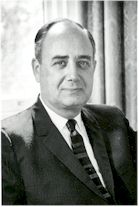Gordon Teal
- Birthdate
- 1907/01/10
- Birthplace
- Dallas, TX, USA
- Death date
- 2003/01/07
- Associated organizations
- Bell Labs
- Fields of study
- Semiconductors
- Awards
- IEEE Medal of Honor
Biography
Gordon Kidd Teal was born in Dallas, Texas, on 10 January 1907, and educated in the Dallas School System. He earned the Bachelor of Arts degree in mathematics and chemistry "with honor" at Baylor University in three years. He then entered Brown University for graduate study leading to the Master of Science and Doctor of Philosophy degrees. There he was a Marston Scholar, University Fellow, Metcalf Fellow and received a University Scholarship. His thesis involved studies and investigation of the chemical-electrical properties of germanium.
In 1930, Teal began his career of creative research and innovation at Bell Telephone Laboratories at the invitation of Drs. R. R. Williams and Robert M. Burns. His personal research resulted in forty-five patents and a number of key papers on the preparation and control of electronic materials in order to achieve and understand reproducible physical properties of scientific and technological significance. He is best known for the results of his research in germanium and silicon and in particular for the preparation of the first high-purity, high-perfection, single-crystalline germanium for transistor use. He was a co-developer of the first junction transistor. As stated by W. Shockley (Nobel Laureate, 1956) "There was probably no more important scientific development in the semiconductor field in the early days following the announcement of the transistor than the development of high-quality single crystals of germanium at Bell Telephone Laboratories."
During the depression years, 1932-35, Teal took advantage of the reduced hours at BTL to become research associate of Harold C. Urey (Nobel Laureate in chemistry) at Columbia University. One of the results was a review of all research on heavy hydrogen published with Urey.
In 1953, Teal joined Texas Instruments partially to return to his home town and partially to found and build TI's Central Research Laboratories. Best known developments under his direction are the first commercial silicon transistor (1954) and a chemical reduction process for ultra-pure silicon (1957). According to opinions summarized in Fortune (November 1961), "The silicon transistor was a turning point in TI's history. . . . TI sales rose almost vertically; the company was suddenly in the big leagues." Other developments included digital signal processing for oil exploration and infra-red detectors. These were of major importance to the nation's economy and security as well as TI's economic welfare. Teal was particularly proud of the outstanding talent recruited and developed and their subsequent impact on TI. Teal became International Technical Director for TI during 1963 and 1964 thereby fostering their growth as an international company. He resided in England, France, and Italy and was most active in their scientific and industrial life.
In 1965, Teal took leave of absence from Texas Instruments to become the first Director of the National Bureau of Standards' Institute for Materials Research in Washington, D.C. He introduced an imaginative and lively interpretation of government's planning system (PPBS) as applied to science, and took unique steps to expose the managerial talent under him to high level personnel in successful U. S. corporations.
Teal resumed his position at Texas Instruments and was Vice President and Chief Scientist for Corporate Development from 1968 until 1972, the year he retired. Afterward, he served as a consultant.
Teal held most chairs at IRE Dallas Section level and helped create DIRECTION Magazine. He was a major contributor to the merger of the AIEE and IRE. He served as a Director and President of Texas Academy of Science and as Chairman of the Board of the Council of Scientific Societies of Dallas-Ft. Worth area which he was instrumental in creating. Honors include: Outstanding Alumnus Award, Baylor University; Member, the Cosmos Club (Washington); Fellow, Washington Academy of Science; Fellow, Institute of Electrical Engineers (United Kingdom); Inventor of the Year Award, The Patent, Trademark, and Copyright Research Institute of the George Washington University. He received the IEEE Medal of Honor in 1968, “For his contributions to single crystal germanium and silicon technology and the single crystal grown junction transistor.”
Teal was married to the former Lana Smith, a fellow Baylor graduate who was also recognized for high scholastic achievement. They had three sons, Robert, Donald, and Stephen . The couple were also Members of the Board of Directors of the Dallas Museum of Contemporary Art. Teal passed away on 7 January 2003.
Further Research
Frederik Nebeker, "Finding the Right Material: Gordon Teal as Inventor and Manager," in Sparks of Genius: Portraits of Electrical Engineering Excellence (Piscataway, NJ: IEEE Press, 1994), 93-126.
Gordon Teal IEEE Oral History.
